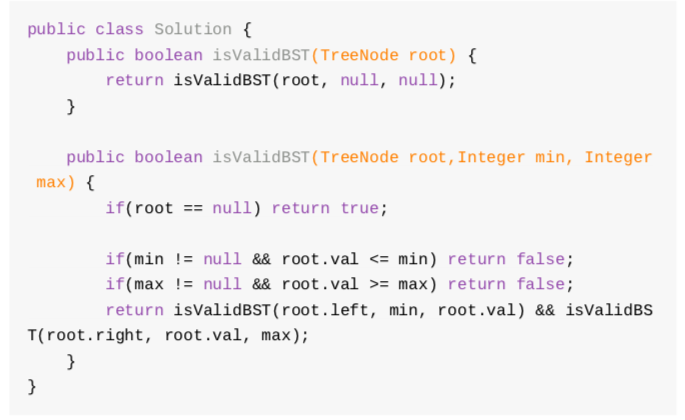[抄题]:
[思维问题]:
不知道要定义resultType, 其实用仔细分析判断条件就行了:是否是bst+最大最小值
类似于平衡二叉树:是否平衡+左右的高度差
[一句话思路]:
[输入量]:空: 正常情况:特大:特小:程序里处理到的特殊情况:异常情况(不合法不合理的输入):
1-1也不是。所以left.max >= root.val也不行
[画图]:
[一刷]:
- 空节点可以认为是平衡二叉树
- 只有在root.left非空,并且直接拿left.max比root的取val大时,才能否定
- 最后可以直接返回left.min, right.max
[二刷]:
[三刷]:
[四刷]:
[五刷]:
[总结]:
定义结构-helper方法-(边界条件-不符合的情况-符合的情况)-调用helper方法
[复杂度]:Time complexity: O(n) Space complexity: O(n)
[英文数据结构,为什么不用别的数据结构]:
[其他解法]:
[Follow Up]:
[LC给出的题目变变变]:
BST中出现最多的元素:中序遍历,然后计数统计

public class Solution { /** * @param root: The root of binary tree. * @return: True if the binary tree is BST, or false */ public boolean isValidBST(TreeNode root) { ResultType r = validateHelper(root); return r.is_bst; } private ResultType validateHelper(TreeNode root) { if (root == null) { return new ResultType(true, Integer.MIN_VALUE, Integer.MAX_VALUE); } ResultType left = validateHelper(root.left); ResultType right = validateHelper(root.right); if (!left.is_bst || !right.is_bst) { // if is_bst is false then minValue and maxValue are useless return new ResultType(false, 0, 0); } if (root.left != null && left.maxValue >= root.val || root.right != null && right.minValue <= root.val) { return new ResultType(false, 0, 0); } return new ResultType(true, Math.max(root.val, right.maxValue), Math.min(root.val, left.minValue)); } }
也可以不定义resulttype 不用这种奇葩思路。直接在isvalidate函数中定义节点为空或者大小不对就行了

